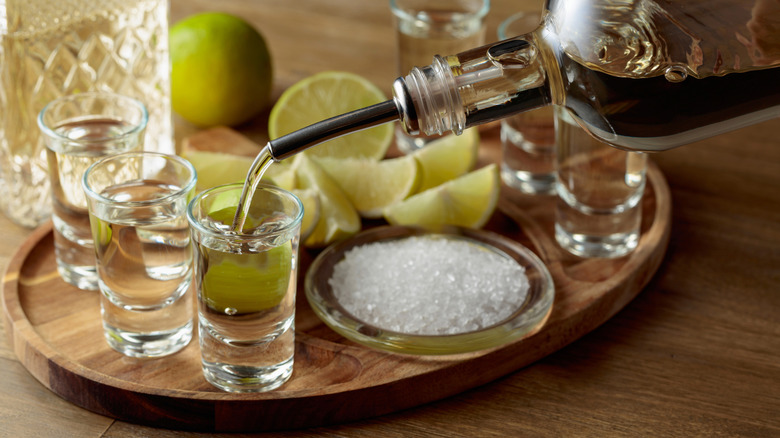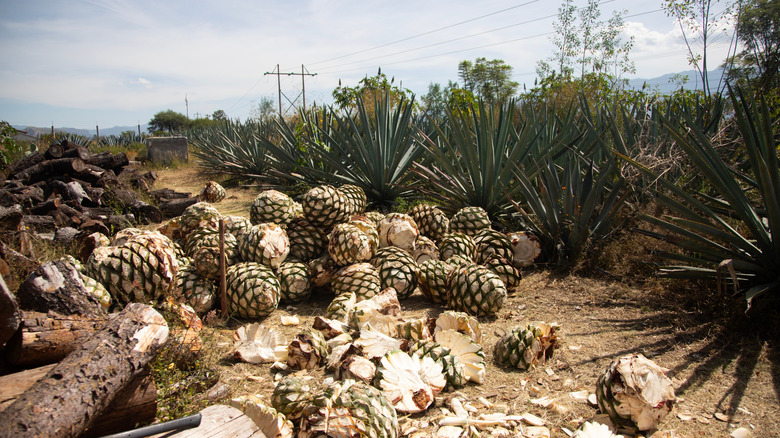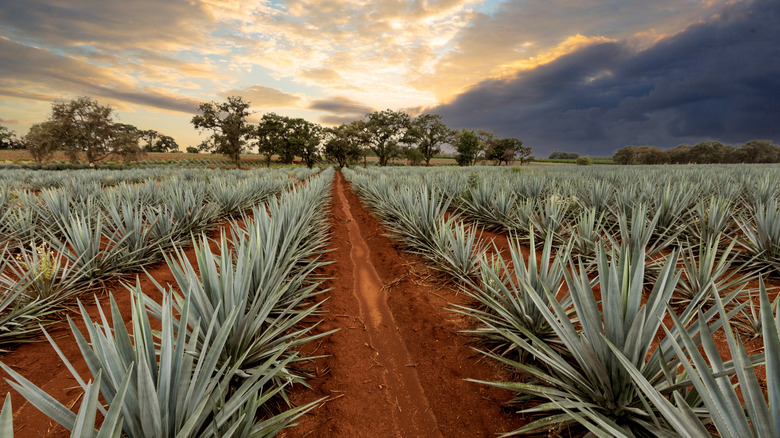The Difference Between Agave Spirits And Tequila
Tequila is undoubtedly the best known of the agave spirits. Whether it's taken as a shot — preceded by a lick of salt and followed with a bite into a lime slice — mixed into a margarita, or used in TikTok's questionable tequila and apple juice cocktail, tequila is known and enjoyed around the world. But it is far from the only agave liquor out there. So, what actually separates tequila from the others? Mostly a bunch of restrictions.
In order for a liquor to be called tequila, it must follow a bunch of rules. For example, the alcohol content must be derived from at least 51% Blue Weber agave. The other 49% of the alcohol can come from non-agave sources, but may not be derived from any other variety of agave. Tequila labeled as 100% agave must be made entirely with alcohol fermented and distilled from Blue Weber agave. Additionally, tequila must be produced in one of the Mexican states of Jalisco, Guanajuato, Michoacan, Nayarit, or Tamaulipas. Just as Champagne is named after a region of France, so too is tequila named after the town of Tequila in Jalisco, Mexico. Agave-based liquors that do not meet these requirements must be known by names like mezcal, bacanora, or just plain "agave spirits."
Beyond those restrictions, tequila is also separated from other agave spirits by the methods of production. All agave liquor is made from the cooked hearts (or piñas, so called because they look like pineapples) of the agave plant, but for tequila, this is done with steam. The cooked agave is then crushed to release the juice, which is, in turn, fermented and distilled. The process is fairly similar to other agave spirits, but as we dig into their production methods you will see how they differ from tequila, and how that creates very different results.
Mezcal, tequila's more relaxed brother
The difference between mezcal and tequila is much like the difference between bourbon and whiskey. Just as all bourbon is whiskey, but not all whiskey is bourbon all tequila is mezcal, but not all mezcal is tequila. In fact, the first tequila was known as vino de mezcal de la región de Tequila, meaning "mezcal wine from the Tequila region," a reference to the distilled spirit of mezcal (which comes from the Nahuatl word for cooked agave).
If you've ever tasted mezcal, you know that it bears a signature smokiness — enough so that a mezcal Manhattan is aptly named a "Smoke Break." This flavor comes from the traditional production methods, in which the agave piñas are baked in underground ovens to release their sugars. This baking adds a distinct smokiness that is not present in tequila (as tequila uses steam cooking).
Another unique characteristic of mezcal is that it can be made using any agave plant — and there are many to choose from. Espadín agave, a genetic forebear to blue agave, is one of the most popular varieties for mezcal, but there are 50 different agave species used in mezcal production, each with its own unique flavor. Next time you are in the mezcal aisle, look for bottles made with tobala and cuishe. Taste these next to an espadín to begin your crash course on the smoky Mexican liquor that is mezcal.
The other agave spirits
While you might think that the broad description of mezcal would mean that we were done with agave spirits, you would be wrong. There are far too many other categories to mention them all, but to give an idea of the breadth, we will touch on bacanora and "agave spirits."
Bacanora is a regional mezcal from Sonora, and must be made with a local subspecies of the espadín agave known as pacifica, yaquiana, or bacanora. Made just like other mezcals, it has a similar flavor, though it is quite approachable for newcomers to the scene, with less smoke as well as floral notes, a touch of spice, and an earthy tang.
Finally, we have the catchall, "agave spirits." This category covers any liquor made from agave. If it is produced in the United States, it must be called an agave spirit. Tequila, mezcal, and bacanora all have regional requirements to their production. While "agave spirit" doesn't have quite the same mystical, historical ring to it that these other liquors do, don't write it off. In the absence of rules regarding production methods, agave spirits have the lots of freedom to explore with new methods.
Without a doubt, tequila garners the most attention of the agave spirits, but that may be changing. Margaritas and palomas have left their mark on the world, but there are always great depths to liquors like mezcal, bacanora, and agave spirits, and that doesn't even include those we didn't mention, such as raicilla, pechuga, and sotol. We have just scratched the surface — there is a wide world of agave spirits out there.


